To bring to life the concepts and ideas discussed in The Great Rethink series, we bring together experts in the field, who can offer first-hand experience and important insights on these topics. This Q&A focuses on how a changing understanding of Value is impacting the advancement profession, both in recruitment and retention:

Heidi Hansen McCrory is the University’s Chief Advancement Officer and is responsible for annual and endowment support, planning and solicitation of major gifts, and campaigns, alumni and parent relations, and donor relations. She joined Furman in 2018 after four years as Vice President for College Relations at Kenyon College in Ohio. McCrory previously spent 14 years at Sweet Briar College in Virginia, in multiple senior development roles. Heidi is a graduate of Southern Methodist University, and she earned a master’s degree in English at the University of North Carolina at Greensboro. She is the faculty chair for the Council for the Advancement and Support of Education (CASE), a summer institute for new fundraisers, and serves on the board of the Girl Scouts South Carolina – Mountains to Midlands council.

Stephen Ackley-Ortiz is Chief Development Officer at the Institute for Advanced Studies, where he leads the advancement team, enacting a comprehensive program to support IAS in its mission to expand fundamental knowledge and foster global collaboration across disciplines. Prior to joining IAS, he served as Director of Development at Yale Law School, where he oversaw all individual giving programs and held several leadership positions in the school’s office of development, from planned and principal giving to alumni engagement. Stephen completed his undergraduate education, summa cum laude, at the University of North Carolina at Greensboro, and earned his M.A. in Spanish and Portuguese from Yale University. He received a J.D. from Yale Law and worked in private practice before beginning his career in development.

Noelle DeLage is Chief Development Officer at the Denver Zoo, where she leads a team focused on increasing private support for the Zoo by actively engaging in meaningful relationships with donors at all levels of giving. Before joining the Denver Zoo, she served as Assistant Vice Chancellor of Advancement at the University of Colorado Denver, where she led a major gifts team that made a significant contribution to the highest fundraising totals in the school’s history. Previously, at the Denver Art Museum, Noelle focused on foundation and government funding, securing grants for groundbreaking exhibitions and educational programs. Throughout her twenty-year career in philanthropy, Noelle has been committed to strengthening Colorado’s cultural, scientific, and educational resources.
This roundtable discussion was moderated by Ron Schiller, Founding Partner and Senior Consultant at Aspen Leadership Group.
RS: So, The Great Rethink was our response at Aspen Leadership Group to hearing a lot about the ‘Great Resignation.’ Because that’s not what we were seeing in our search work. People aren’t just saying, ‘I’m done. I’m done with fundraising. I’m done with advancement.’ We have heard people saying, ‘You know, these recent experiences have really caused me to think about things differently.’ It was much more about seeing the world a little differently. And that includes rethinking all the many issues related to Value – how we think about Value, how we recognize and reward it, and the expectations around Value by candidates and hiring organizations.
Let’s open by just sharing our thoughts on this concept of Value and how it may be changing, what you’re all seeing and grappling with, and what you may have gone through during and coming out of the pandemic. Heidi, do you want to start?
HM: It feels like the last few years have been cataclysmic in terms of change. I’ve been in this business a very long time, and it was crystallized for me about a year ago when I heard a colleague say that she used to fit her life to her work, and coming out of the pandemic, she was going to fit her work to her life. That, to me, sums up the big impact.
One of the things I worry about regarding goals and expectations, at least in advancement, is that goals and expectations are based on people fitting their life to their work in a way that’s not happening so much anymore. So, we’re in a time of tension between differing expectations.
There are a lot of challenges around the issue of Value in the nonprofit space. While money, salary, and benefits are always going to be a challenge for us in the nonprofit space, I also think we have an amazing opportunity now to be more intentional about Value, including things like impact, community, enrichment, and optimism – the things that nonprofits deliver for society.
RS: Noelle, Stephen, thoughts on that?
NDL: I completely agree that the conversation around life/work balance, for lack of a better term, has completely changed. There’s some different thinking, generationally speaking, that requires managing, but clearly, the idea of work crowding out your personal life is just not acceptable anymore. Nobody wants that.
But the zoo is an in-person business, and a large portion of our workforce is in-person 100% of the time. So, we ran into a couple of things coming out of the pandemic related to the virtual space, which the article talked about a lot in terms of being competitive for candidates. We can’t offer 100% virtual. It’s just not possible, but we do offer a ton of flexibility and there’s no questioning that on the team.
And so it becomes a cultural question of how we integrate those who are on-site in the zoo alongside those who are doing the office work. There are questions of equity around that, and equity issues have become central to many conversations we’re having at the organization – particularly around fundraising and the donors we’re offering the opportunity to support us. My younger team members really relish being engaged in those conversations, and that’s an example of places where I can add Value.
RS: Stephen?
SAO: Remote work and spending more time at home gave us all the opportunity to rethink our values and what’s important to us, and how to shape work around our life rather than the other way around. We really spent time thinking about what we want, and what we value. But we also saw how much happened organically in an office setting, in terms of personal interaction, that was missing from remote work.
Our understanding has changed, but different conclusions about the balance between remote and in-person interaction created some tension around expectations. Those forces pushing against each other also contributed to a lot of people moving around in the profession. That movement, in turn, has created pressure for organizations to continue to rethink, prompting the conversation that we’re having now.
RS: So, let’s talk a little bit about money. There have always been pressures to pay more for your best performers, both to recruit them and keep them. Yet, the supply/demand equation has gotten more difficult.
It’s much harder to find those people. They have more choices. There are more jobs open for every great fundraiser or advancement staff member. There’s inflation, which is increasing costs. Rather than the 2%, 3%, and 4% raises we all got used to over the past several decades, suddenly salaries are rising 7%, 8%, and 10%.
What are you seeing, and how has the money part of the Value equation changed, not just in trying to attract candidates, but also in keeping top staff from being recruited away, and maintaining equity across your teams?
SAO: The Great Rethink is very much about thinking differently about Value, and certainly part of that is looking at soft value. But here’s where I start: for those softer elements of Value to really matter, to feel authentic to the team member, you have to at least be in the game in terms of salary. That’s where I start when we talk about money.
As Ron knows, I arrived here to a team of three full-time staff and one part-timer, and when the build-out is complete, this will be a team of eleven. And so, as we compete to attract new staff, it has been a challenge. When I first wrote up job descriptions, I felt like I needed another page in The Wall Street Journal to keep track of what the market rates actually were in these different positions. Every day, it seemed I was being told higher numbers. The COO and I worked very hard together to understand where the market was and what it would take to be in the game.
Yes, we have these other intangibles. And I worked hard in my conversations with candidates to help them understand the kind of office I’m building here – the things that I value and can deliver, the kind of team experience that I wanted to create, the mission of the organization, its work and impact, and the aim of working together to find joy in what we do. Just the same way I talk to donors, I tell candidates, ‘I want to find the thing that brings you joy.’
But the arms race in salary is real. And it creates equity issues when new people come in at higher levels than existing staff. I feel, if we’re going to be transparent and fair, that we have to make those adjustments as well, which can be really difficult for financially constrained teams. So, the money part of Value is incredibly important, and you’ve got to be at least in the game so that the other soft aspects of Value don’t sound inauthentic.
RS: Noelle?
NDL: First I would say, Stephen, congratulations on beginning that process. It’s exciting but daunting at the same time. I rebuilt the team at the zoo four years ago when I went through the process with ALG, and now I’m really focused on retention.
So, Colorado recently passed a law that all salary ranges need to be published with postings, and that was a game changer for us. It has made people feel very comfortable talking about their salaries when they believe they deserve a raise, and just generally engaging in money conversations. It’s been a growth opportunity for me to become comfortable with that as well. And I think it’s healthy, in particular for frontline fundraisers, to be comfortable talking about money. If they’re comfortable talking about their salaries and their own financial status in the world, they’re going to be more comfortable speaking with donors about it.
I also have to credit our Senior Vice President of HR, whose team is very good at doing proactive salary studies, to keep tabs on the market. I feel very supported by my organization in making the right decisions for my team. Because pay equity requires a unified vision across the entire organization. While money doesn’t buy everything, it’s really important that we stay competitive. Then we can have conversations about making sure people feel valued through all aspects of their work, including the mission, doing special projects, work/life balance, or any of the other softer aspects of Value such as professional development and recognition programs.
RS: I want to stop for just a moment on your statement. Salary transparency can feel scary. Some organizations resist it because it can create a cost challenge, as many other costs are also going up. But it feels like you’ve discovered another benefit to salary transparency: It can make people more comfortable having conversations about money and Value, inspiring some people to advocate for themselves in a way that they maybe didn’t feel before culturally, or socially, or for some other reason. It can also help frontline fundraisers be more comfortable talking about money with donors. Heidi, what has your experience been with salary transparency?
HM: We don’t publish salaries. So, we haven’t encountered any of those issues yet, but like every organization, we do try to achieve balance and equity when bringing in someone new at a higher level – moving quickly to raise other team members to those higher levels. Noelle mentioned the support of HR and leadership, and here I would sing the praises of my President and our VP for Finance. They understand our ROI in the advancement areas, which over the last few years has been anywhere from 800 to 1,200%. So, they get the importance of keeping a good team in place. This brings me back to Noelle’s comment about retention. That’s a really critical piece.
RS: Can you say more about that?
HM: One point I would make is we’ve been more successful hiring advancement staff who have either a commitment to the university, meaning they’re alumni, they’re parents, they have some connection to Furman that creates value and brings some value, or they have a commitment to the Greenville community. Those folks are more likely to come and stay. The folks who want to drop in, raise a little money, and get out of town to the next big job, that revolving door is always spinning, but when folks have a connection to who we are, or where we are, we see more success with keeping them.
Now, the keeping them piece, I’m a big advocate for the ‘org chart on an Etch-A-Sketch.’ You carefully draw all your boxes and make sure all the boxes are the same size because everyone’s going to measure those. Make sure the lines all work. But then when you do lose somebody, or an opportunity presents itself, you take that Etch-A-Sketch, turn it over and shake it, and start again.
We all get very tied up in those boxes, and what we should be focused on is not the box, or even the job description, but the person and the talents they bring. So from a retention standpoint, and when we talk broadly about Value, particularly this generational difference, and wanting to be in the conversations, wanting to be heard, wanting to deploy their breadth of strengths – that’s where it helps to be able to say, ‘Can we change this person’s job enough to make them successful and bring their skills and talents to something new?’ Hence the Etch-A-Sketch org chart.
Knock on wood, we’ve been pretty stable through the last couple of years, with only a handful of departures from a staff of forty-three. Part of our ability to keep the team stable is our ability to promote from within. For almost every position we’ve had open, we’ve promoted somebody internally to fill it. That keeps staff more engaged, I think, and more interested and excited about being here.
RS: You know, we all have this great privilege of working with donors, generous individuals, families, and organizations. And we learned a long time ago the value in listening and showing them that we hear them and that we are invested in their joy, as you said, Stephen.
And I will tell you that when I’m talking to candidates when they talk about feeling valued, and about a supervisor who is investing in them, they almost never mean a supervisor who is throwing more and more money at them. They almost always mean somebody who has listened to their professional goals, who has changed the org chart via the Etch-A-Sketch and let them try something new, without having to go to an entirely different place or an entirely different job in order to try it.
This is what people mean when they say to me ‘I won’t leave there even though I could make 20% more. I don’t know that a new supervisor is going to invest in me in the same way that my current supervisor does.’ So, you’ve given us some wonderful thoughts on how to demonstrate to an employee that they are valued beyond just the money.
Noelle, Stephen, what are some other thoughts you have on demonstrating that kind of investment? So that when someone tries to recruit them away, that staff member might say, ‘This place is invested in me. So this isn’t the right time.’
NDL: Well, I would say a couple of things. First, our organization, as a whole, conducts an annual internal survey, which is used as a Key Performance Indicator. This year we exceeded our wildest dreams and we’re celebrating that. I also tried something new, turning over the survey review meeting to my team, where they led the meeting and talked about the results in a way that they felt was meaningful to them—giving them some control over the conversation, making that meeting a place for them to create Value.
I also think, getting back to the work/life balance, we can’t be afraid to talk about life outside of work. In particular, as women of a certain age, we were taught that you don’t bring life issues to the workplace. And I’ll tell you, I had two children, and it ruined an experience at a workplace where I did not feel supported. Even though I was raising a lot of money, I left and dropped out of fundraising for a period of time.
I don’t want that to happen on my watch. So I’m committed to families, however, they look, and I have the support of the organization behind me. We recently came out with a parental leave policy that is the most generous policy I’ve ever seen. And we have open conversations about family and parenting issues that I would have never dared to have as a young person. I’m proud that we support each in this way because our people are valuable to us. My experience has been that if we support families, and they feel supported, they’re going to stay. They’re going to grow with us. As Heidi talked about, being the kind of organization that can capitalize on people’s strengths and help them to grow — as people and as employees – that’s where the Value is going to be.
RS: Stephen?
SAO: First of all, I just want to say that I love that imagery of the Etch-A-Sketch org chart. I’ve embraced that for a long time, during a career that has been spent entirely working in small shops. I believe in letting all the flowers bloom. I want to know all of your talents. Even if something might not belong in your portfolio, under a traditional org chart, that’s not what matters. What brings joy, what brings a feeling of being valued, is the ability to use the talents you have, even if it doesn’t fit neatly into the silo we think about in a particular role. So, I think that’s just really key.
Second, as people come and go, different talents come and go with them. So, there’s a change in culture. Everybody adds and changes the culture of the office as they come and go. Now, when someone leaves, our natural instinct is to get that original job posting up right away, without asking if that’s still the right role.
Any time you have a departure, it’s an opportunity to have a fresh look at everybody’s talent. And you know, in small shops we don’t have so much opportunity to promote from within. But even if we can’t move somebody to a different role, we may be able to expand their current role in a way that’s valuable to the organization, to our mission, fills the gap left by a departing staff member – and at the same time allows them to feel valued as an important contributor to mission and impact.
RS: So, Stephen, you just mentioned mission, and Heidi, earlier, you talked about the retention success or the higher likelihood of retention success with people who had some other connection, some other reason to be there, graduate, parent, whatever it might be. I’m wondering if we can spend just a few minutes talking about the importance of mission to the overall package of compensation/retention tools that are in your toolbox.
Early in my career, when I was at Cornell University, I was a graduate as well as an adjunct faculty member, and then an advancement staff member. So I knew the university very well. And I was there long enough to see the development program outgrow the campus and get moved to a local airport business center, where it remained for a very long time.
After about two years of being out there, I realized that many of the members of the team had no connection to Cornell beyond their job, rarely set foot on the campus, and weren’t engaged in the life of the university. They would drive to the airport and then drive home. And I realized, ‘Wait a minute. They’re not getting the joy. They’re not getting the benefit of feeling like a part of this community.’
So, I’m wondering if we can just spend a few minutes thinking about how valuable this sense of community and mission is. Maybe you could speak personally for a moment about being connected to your particular organization and its mission and how it contributes to Value.
SAO: For me, in my first conversation with the dean of Yale Law School about leaving the practice of law, and coming to work at my alma mater, he asked me point blank, ‘Stephen, is this about coming to work at Yale Law School or is this about a new career in philanthropy?’ I said, ‘Well if you’re asking me if I could do this anywhere, the answer is no. I have to be at a place where I really believe in the mission.’
Ron, you and I have had this conversation. I am interested in working at places that have an impact on the world. And in my conversations with candidates here, it’s an enormous draw. They want to work for a place that’s contributing to the world in the way that IAS has.
NDL: I used to work for a university where I had a degree from, and it was a point of pride. I knew the culture of the place, and that probably kept me there longer. I have not worked in the corporate space for thirty years, but I can tell you when I did, I did not feel that way. So, I think mission is very important to what we do here.
Now I’m at a nonprofit cultural institution with a recently launched strategic plan, giving us a great platform to double down on the mission. It helps position our conservation message to folks who might not be zoo people, explaining what a zoo is now and how zoos have changed over time. We’re going to be rebranding soon, to further amplify that conservation part of our mission.
Also, for us, the in-person piece is really important. A lot of working at a zoo is about touch, feel, and experience. We create experiences for our donors that they can’t have anywhere else, and we have experiences as employees that other people don’t have. Finally, there is an aspect of learning that I think is particularly attractive for folks who are drawn to nonprofits.
RS: So if you can imagine two conversations, trying to retain two people who have an offer of 10% more in salary elsewhere – one has real stickiness to the mission and one doesn’t. Is there really a difference between those conversations? Does mission really matter when it comes to recruitment and retention?
NDL: I think it can, especially when the entire team is tuned into the mission. Our team right now is very gelled, and I hear a lot from them, ‘I really love this team.’ There’s shared accountability, everybody’s together. And I think, on a micro level, it’s very important to develop that shared sense of mission and impact.
SAO: I’d like to add something here about supporting our teams, and our people that’s central to our ability to cultivate that sense of mission. It’s an unfortunate habit in advancement that we pile portfolios on people, often creating unrealistic expectations regarding success. The Chronicle of Philanthropy recently ran an article about people leaving advancement, and one person said, ‘I come to work every day and what is expected of me is impossible. I cannot achieve it. So every single day, I wake up feeling like a failure, and when I go to sleep at night, I feel like I have failed.’
That’s a miserable thing to experience. But it’s even more miserable in our world. When you work at a place you love, where you believe in the mission, failing hurts even more deeply. So, it’s critical that we support our teams by having realistic expectations and positioning them for success. That’s something that’s hit me recently, and in many ways, we as an industry have been failing at it.
NDL: Stephen, I so agree with you, from a tactical point of view, making that happen requires that managers are trained in having that supportive mindset. My job is to support the success of the people who work on my team, period. That’s it, and that’s the job of my managers. So, they have to be skilled in having difficult conversations. They have to be courageous every day. And we as leaders need to be courageous, genuine, and transparent.
It’s easier said than done, but boy does it work much better if we’re able to do that. And people feel valued when you come to them with an honest conversation, even if it’s a difficult conversation. We can’t be afraid of those.
RS: That’s another important element of Value – we’re hearing that more than ever – coming out of the pandemic, people struggling to find a direct connection from themselves to that impact. Some are actually moving to smaller shops as a result of that. But Heidi, I’m going to give you the last word today.
HM: I would say a couple of things. When students ask me for career advice, I always say, ‘Do what makes your heart sing, whatever that is.’ That’s usually something to do with mission. It’s not just important; it’s fundamental and central to what we do. We can train people to do the work and be great development officers if they believe in the mission.
And these days, we all feel a bit like we’re working at the airport business center because of the new hybrid work situation. So, we have to wake up every day and be intentional about connecting people to our mission and thinking about how to do that. Otherwise, we’re just transactional, when our whole business is about relationships. We talk a lot about creating relationships with donors, to help them find joy and impact. The days are over when you’d drop a proposal in front of the donor and say, ‘We want you to consider this gift.’ It’s all about a conversation with the donor.
So, it always surprises and horrifies me that we don’t use that same philosophy and construct when we think about our own teams and our own staff because if we brought all those sensibilities to our internal volunteers, donors, and audiences, I believe we would have less turnover. We wouldn’t hear about terrible, horrible bosses and supervisors. We would solve a lot of our problems if we could do that.
RS: That’s a great place to end. Thank you all. You add so much to the industry and I’m really glad you were all available to do this. Thank you for the care and thought that you put into it as well. Hopefully, it will help spark many productive and thoughtful conversations about this very important topic of Value.
Curious to learn more? Read the next article in our series here.



